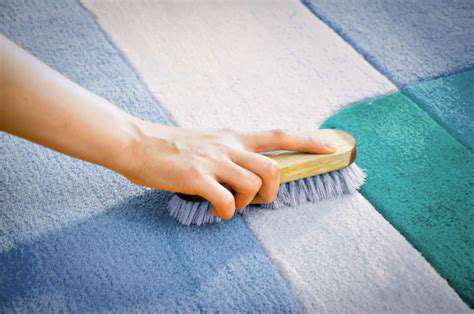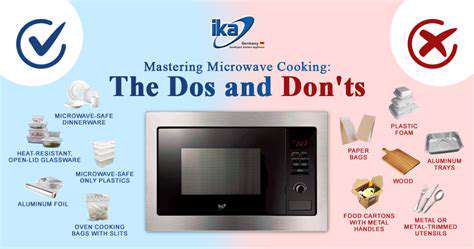Kitchen Cleaning Hacks: Sparkle and Shine

Pre-Treatment Strategies: A First Line of Defense
When dealing with stubborn stains, taking quick action makes all the difference. Addressing spills immediately dramatically improves your chances of complete removal. The type of fabric and stain composition play critical roles in determining the right approach. Grease stains, for instance, demand different treatment than protein-based stains like blood or egg yolk.
Blotting—not rubbing—should always be your first move. Rubbing can embed the stain deeper into fabric fibers. Keep clean cloths or paper towels handy to gently absorb liquids before they set.
Identifying the Culprit: Understanding Stain Types
Effective stain removal begins with proper identification. Is that spot from cooking oil, pen ink, or last night's merlot? Each stain type requires its own specialized treatment approach. The chemistry behind different stains directly influences which cleaning methods will work best.
Fabric considerations matter just as much as stain identification. Delicate materials like silk demand gentler solutions than sturdy cotton blends. Always check care labels before proceeding with any treatment.
Water-Based Stains: A Gentle Approach
Common beverage spills respond well to simple solutions. Start by dabbing the affected area with a damp cloth to lift surface residue. Aggressive scrubbing often does more harm than good, potentially damaging fibers and spreading the stain.
Mild dish soap mixed with cold water makes an effective first-line treatment. After application, thorough rinsing prevents soap residue from attracting more dirt over time.
Grease and Oil Stains: Absorbing the Attack
Oil-based stains require a different tactical approach. Immediate absorption proves crucial before any cleaning attempts. Use clean materials to blot from the stain's outer edges inward, containing the spill.
Once excess grease is removed, apply a degreaser or diluted dish soap solution. Gentle dabbing works better than vigorous rubbing, which might push oils deeper into fabric.
Ink Stains: A Delicate Dance
Pen marks present special challenges. Speed matters tremendously with ink spills—delay often means permanent stains. Always test cleaning solutions on hidden fabric areas first to prevent damage.
Specialized ink removers or alcohol solutions can work wonders. Apply sparingly and blot carefully, working from the stain's perimeter toward the center to prevent spreading.
Protein-Based Stains: A Time-Sensitive Situation
Biological stains become increasingly stubborn over time. The clock starts ticking the moment these spills occur. Quick action with absorbent materials helps minimize permanent damage.
Cold water works best for initial treatment—hot water can set protein stains. Gentle detergent solutions often suffice, though specialized enzyme cleaners may be needed for persistent cases.
Stubborn Stains: Advanced Techniques
When standard methods fail, consider professional-grade solutions. Valuable or delicate items often warrant expert intervention. Steam cleaning or specialized products might salvage what home remedies cannot.
Always follow manufacturer guidelines precisely when using strong cleaners. Preliminary spot testing remains essential—what works for one fabric might ruin another.
Mastering the Microwave and Oven: Easy-Clean Strategies

Understanding Microwave Cooking
Microwave technology heats food by energizing water molecules. This efficient process excels at reheating and defrosting tasks. Learning how different foods respond to microwave energy prevents uneven cooking and dryness. While preset functions offer convenience, understanding power levels yields better results.
Experimentation helps develop microwave proficiency. Adjusting cook times and power settings transforms this appliance from a simple reheater to a versatile cooking tool.
Oven Cooking Fundamentals
Traditional ovens unlock greater culinary possibilities. Precise temperature control separates mediocre results from exceptional ones. An inexpensive oven thermometer provides accuracy that built-in controls often lack—especially crucial for baking.
Altitude adjustments and understanding heat distribution patterns prevent cooking mishaps. The relationship between rack position and air circulation significantly impacts cooking outcomes.
Safety Precautions in the Kitchen
Both appliances demand respect and caution. Manufacturer guidelines exist to prevent accidents and ensure optimal performance. Hot surfaces pose burn risks, while improper ventilation can create hazardous conditions, particularly with gas ovens.
Regular inspection of cords and components maintains safety. Develop habits like using oven mitts and keeping flammable materials away from heat sources.
Choosing the Right Cooking Method
Appliance selection depends on desired outcomes. Microwaves shine for speed, while ovens excel for texture development. Different cooking techniques produce distinct flavor profiles and textures. Understanding these differences informs better meal preparation decisions.
Consider energy efficiency alongside culinary needs. Sometimes combining methods—like microwave par-cooking followed by oven finishing—yields optimal results.
Advanced Techniques and Tips
Water baths and steam techniques elevate oven cooking. Mastering these methods expands culinary capabilities and improves results. Proficiency with both appliances comes through practice and experimentation. Keeping a cooking journal helps track successful techniques for future reference.
Temperature probes prevent overcooking, while proper preheating ensures consistent results. These small refinements make substantial differences in final dish quality.
Shining Stainless Steel and Glass: Simple Techniques for Pristine Surfaces
Cleaning Stainless Steel
Stainless steel appliances maintain their appeal through proper care. Warm soapy water and soft cloths handle most daily cleaning needs. Following the metal's grain direction prevents streaking and maintains luster. Avoid harsh abrasives that create microscopic scratches.
For enhanced shine, specialized cleaners with polishing agents work wonders. Regular maintenance prevents fingerprint buildup and keeps surfaces looking showroom-fresh.
Maintaining Glass Surfaces
Glass elements add contemporary elegance but show every smudge. Mild detergent solutions effectively remove everyday grime when applied with non-abrasive tools. Immediate drying prevents water spots that mar transparency.
Persistent stains surrender to baking soda pastes. Gentle circular motions with soft cloths restore clarity without scratching delicate surfaces.
Preventing Residue and Build Up
Consistency beats deep cleaning marathons. Quick wipe-downs after use prevent stubborn buildup. Keep a spray bottle of cleaning solution handy for instant spot treatment.
Microfiber cloths outperform traditional options, trapping particles instead of spreading them. This proactive approach minimizes intensive cleaning sessions.
Maintaining Your Sparkling Clean Kitchen: Simple Habits for Long-Term Success
Creating a Cleanliness Routine
Establishing consistent cleaning habits transforms kitchen maintenance. Brief daily sessions prove more effective than occasional deep cleans. Target high-traffic areas like countertops and sinks immediately after use.
Dedicate specific times for appliance maintenance. Fifteen focused minutes daily keeps grime at bay better than marathon weekend sessions.
Effective Cleaning Strategies and Products
Tool and product selection impacts results. Surface-specific cleaners outperform generic solutions. Quality microfiber captures debris that regular cloths redistribute.
Technique matters as much as products. Thorough rinsing prevents chemical residues that attract new dirt. Regular tool replacement maintains hygiene standards.
Invest in concentrated cleaners that dilute for multiple uses. Understanding ingredient purposes prevents unnecessary chemical exposure. Proper organization makes cleaning supplies accessible when needed most.
View cleaning as ongoing maintenance rather than periodic chore. Immediate spill response prevents hardened messes. A clean kitchen reflects care for both space and those who use it.
- Low Carb Dinners: Keto Friendly Options
- High Protein Vegan Meals: Delicious Plant Based Power
- Understanding Food Labels: What to Look For and Avoid
- High Fiber Diet Benefits: Recipes for Digestive Health
- Kitchen Organization for Small Spaces: Maximizing Every Inch
- High Protein Smoothies: Power Up Your Day
- Unveiling Japanese Street Food: Takoyaki and Okonomiyaki
- How to Store Eggs for Maximum Freshness
- Kitchen Paint Colors: Creating Ambiance
- Quick & Easy Chicken Noodle Soup: Comfort Food
- Understanding Probiotics: Benefits and Food Sources
- Simple Lunch Ideas: Quick and Delicious